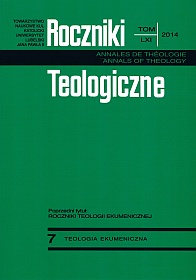“...There Will Be Only One Fold, One Shepherd”. Relecture of John 10,16 in an Ecumenical Perspective
Abstract
The presented article makes a proposal of the relecture of John 10,16 in an ecumenical perspective. The text of John 10,16 says about “other sheep,” which Jesus have to lead so that may arise one flock. The point of departure is an exegetical analysis of John 10,16 in the context of the whole discourse about good Shepherd. The new fold will be composed of two groups, which have been presented figuratively as two groups of sheep. The first group – sheep from the flock (Gr. αὐλή [aulē]) embodies Jesus’ disciples of Jewish origin. The second group – “other sheep” are Christians originate from Gentiles. Both groups will make the one fold. Considering the whole Johannine Gospel, we may say that the beginning of the unification of the fold is the exaltation of Jesus (i.e. His passion, death and resurrection). Since then the incorporation of Christians of pagan origin have begun. The force unifying the new fold will be hearing of the Shepherd’s voice, i.e. acceptance the Revelation brought by Jesus, which will lead to faith in Him. Looking at the text John 10,16 from the ecumenical perspective we may constate: firstly, making the one fold will be a process stretched over time. The way to the unity is long. It has been expressed by the verb γίνομαι [ginomai], which points out the process of making the one fold. Secondly, lots and lots is dependent on how the sheep hear the Shepherd’s voice. Therefore all Christians have to make a permanent reflection about ability to hear the voice of Jesus, i.e. the reflection about ability to understand revelation brought by Jesus. Right cognition and understanding of this revelation is related to serious treatment of biblical research. Since the Bible contains it, what once the voice of the Shepherd annunciated. Right understanding of the Bible makes it, that the Shepherd’s voice is reviving anew in a sense and it draws the next sheep to the one fold.
References
De la Potterie, Ignace. Studi di cristologia Giovannea. Genova: Marietti, 1986.
de la Potterie, Ignace. “Wiara w pismach janowych.” Verbum Vitae 5 (2004), 107–115.
Köstenberger, Andreas. John (Baker Exegetical Commentary on the New Testament). Grand Rapids: Baker Academic, 2004.
Lüdeman, Gerd. Ὑψόω. In Exegetical Dictionary of the New Testament. Vol. 3, edited by Horst Balz, Gerhard Schneider, 409. Edinburgh: T. & T. Clark Ltd, 1990.
Manning, Gary T. Jr. Echoes of a Prophet. The Use of Ezekiel in the Gospel of John and in Literature of the Second Temple Period (Journal for the Study of the New Testament Supplement Series 270), London, New York: T. & T. Clark International, 2004.
Mędala, Stanisław. Ewangelia według świętego Jana. Rozdziały 1-12 (Nowy Komentarz Biblijny IV/1). Częstochowa: Święty Paweł, 2010.
Neyrey, Jerome H. “The «Noble Shepherd» in John 10: Cultural and Rhethorical Background.” Journal of Biblical Literature 120 (2001): 267–291.
Pontifical Biblical Commission, “The Interpretation of the Bible in the Church,” n. III.C.1., http://catholic-resources.org/ChurchDocs/PBC_Interp.htm [20.01.2014].
Popkes, Wiard. “Δεῖ.” In Exegetical Dictionary of the New Testament. Vol. 1, edited by Horst Balz, Gerhard Schneider, 279. Edinburgh: T. & T. Clark Ltd, 1990.
Schnackenburg, Rudolf. Das Johannesevangelium 1-4 (Herders Theologischer Kommentar zum Neuen Testament IV/1, Sonderausgabe). Freiburg, Basel, Wien: Herder, 2001.
Schnackenburg, Rudolf. Das Johannesevangelium 5-12 (Herders Theologischer Kommentar zum Neuen Testament IV/2, Sonderausgabe). Freiburg, Basel, Wien: Herder, 2001.
Schweizer, Eduard. Ego eimi… Die religionsgeschichtliche Herkunft und theologische Bedeutung der johanneischen Bildreden, zugleich ein Beitrag zur Quellenfrage des vierten Evangeliums (Forschungen zur Religion und Literatur des Alten und Neuen Testaments, II. Reihe, 36). Göttingen: Vandenhoeck & Ruprecht, 1939.
The Shepherd Discourse of John 10 and its Context (Society for New Testament Studies Monograph Series 67), edited by Johannes Beutler and Robert T. Fortna. Cambridge: Cambridge University Press 1991.
Witczyk, Henryk. “ ‘Aby byli jedno.’ Sens modlitwy Jezusa w J 17,1-26.” In Biblia podstawą jedności, ed. Adam R. Sikora, Lublin: Redakcja Wydawnictw KUL, 1996.
Witczyk, Henryk. Kościół Syna Bożego. Studium Eklezjologii Czwartej Ewangelii (Biblioteka „Verbum Vitae” 3). Kielce: Biblioteka „Verbum Vitae”, 2012.
Wróbel, Mirosław S. Synagoga a rodzący się Kościół (Studia Biblica 3). Kielce: ITB Verbum, 2002
Copyright (c) 2014 Roczniki Teologiczne

This work is licensed under a Creative Commons Attribution-NonCommercial-NoDerivatives 4.0 International License.





